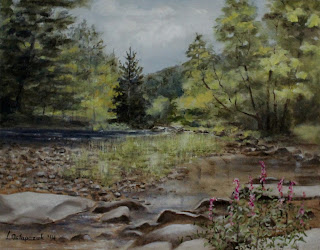Charmed Circle
watersheds: Cecil E. Heacox dubbed a portion of the
Catskills the “Charmed Circle” in the March and April 1969 issues of Outdoor
Life. Heacox’s two part classic article
was titled “Charmed Circle of The Catskills”, a phrase that has stuck to
this region like super glue. In the
March issue Heacox wrote, “I call this region charmed because its fine fishing
in the wild, forested settings has survived even though it is with a day’s
drive of one-sixth of the total population of the United States and Canada. The Charmed Circle has not only survived in
the face of outdoor-hungry hordes, … but it also offers a whole new generation
of fishermen a taste of angling as it used to be.”
Heacox
worked in fisheries for the New York State Department of Environmental
Conservation (NYS DEC) and rose to the position
of Deputy Commissioner before his career was finished. His articles took readers on a journey along some legendary Catskill Rivers, perhaps just like the
landscapes below might.
Roaring
Kill spring, Schoharie Creek, 18x24:
This
is a small tributary to Art Flick’s Schoharie Creek, lost in the Indian Head
Wilderness area. However, it’s not so
lost that Peter Barrett couldn't include a chapter about it--- Old Friends and
the Joys of the Worm--- in his book, In Search of Trout. Conversely Cecil Heacox wrote the following about the Schoharie, "Oddly enough, I remember the Schoharie for what I didn't catch there." And so it is for many anglers who visit this picturesque watershed.
Burroughs
Rondout, above the Blue Hole, 18x24:
If
Catskill naturalist John Burroughs ever favored a single stream, it would certainly be the
Rondout Creek. Read Burroughs 1910
essay, “A Bed of Boughs” and you might quickly reach this conclusion also. And, Heacox wrote “I caught
my first trout” where the Merriman Dam stands in his noted articles above.
Even renowned Catskill flyfisher Edward R. Hewitt wrote about
frustrating fishing days at the Blue Hole, which is perhaps the most famous pool on the upper Rondout. However, there are other crystalline pools above the Blue Hole.
Forest plunge pool, 16x20:
A wilderness section of the Esopus, not far from its source on the Winnisook Club. The
angling member/photographer of this Catskillwatersart consortium loses himself
here every autumn, and this is where he wishes his ashes be spread after his
last breath has been taken.
Maltby
Hollow Brook, 16x20:
A
tributary to a tributary; enough said.
Herdman
Road, Esopus Creek 18x24:
Heacox wrote “The
Esopus, because it was more accessible, became the first trout capital of the
Charmed Circle” not far from here.
Budapest
Lodge, Esopus Creek, 16x20 (Sold):
Esopus
Creek waters upstream of the Portal.














































